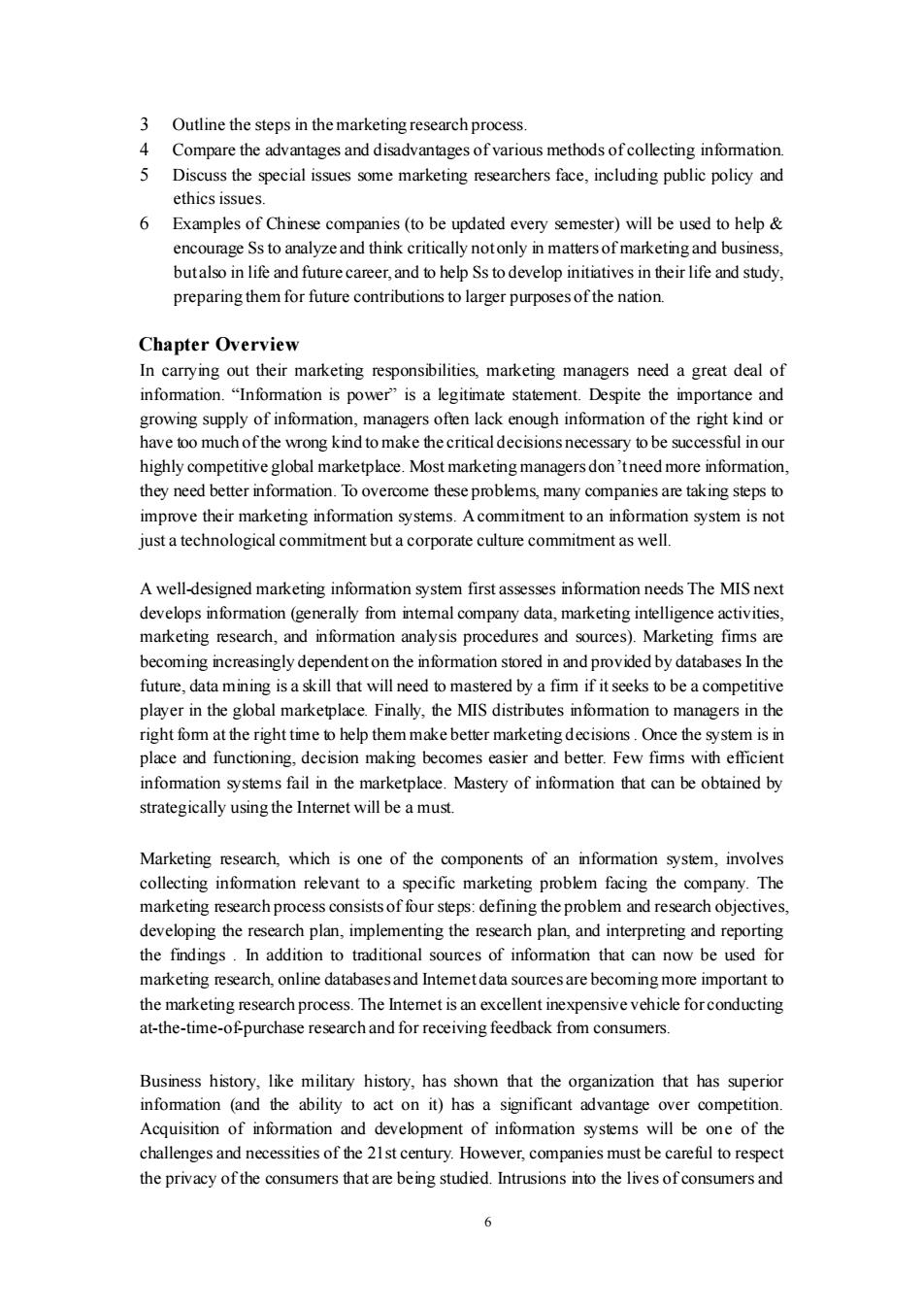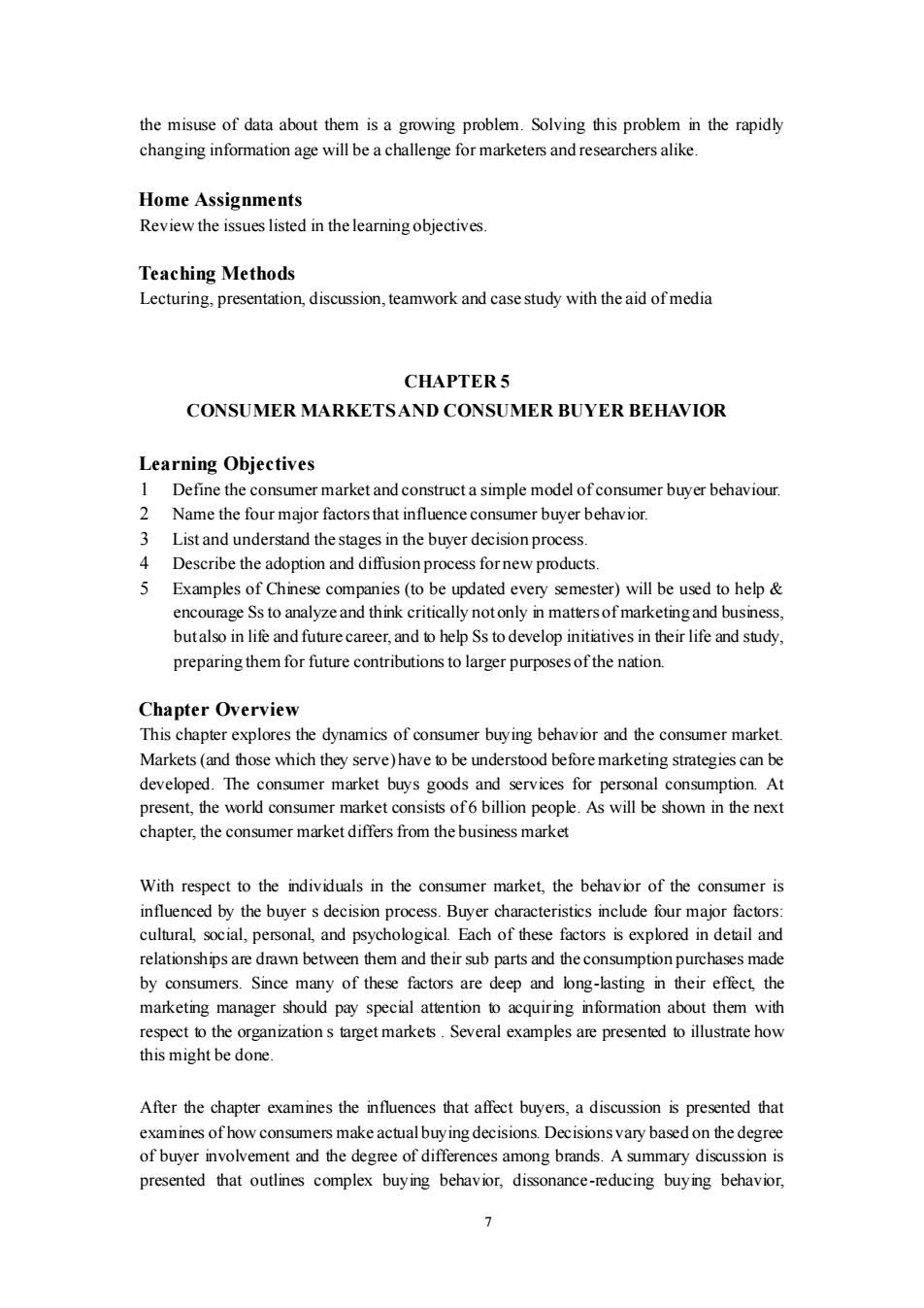
3 Outline the steps in the marketingresearch process. 4 Compare the advantages and disadvantages of various methods of collecting infommatio 5 Discuss the special issues some marketing searchers face,including public policy and ethics issues. 6 Examples of Chinese companies (to be updated every semester)will be used to help& butalso futur preparing them for future contributions to larger purposesof the nation Chapter Overview In carrying out their marketing responsibilities marketing managers need a great deal of infomation.in s power is a gitimate statemen ite the mport e and have too much of the wrong kind to make the critical decisions necessary to be successful in our highly competitive global marketplace.Most marketing managers don'tneed more information, they need better information.To overcome these problems,many companies are taking steps to not A well-designed marketing infommation system first assesses information needs The MIS next develops information (generally from intemal company data.marketing intelligence activities marketing research,and information analysis procedures and sources).Marketing fims are future,data mining is a skill that will need to mastered by a fim if it seeks to be a competitive plaver in the global marketplace.Finally.the MIS distributes infommation to managers in the right fom at the right time to help them make better marketing decisions.Once the system is in place and functioning.decision making becomes casier and better.Few fims with efficient nfomation ystems fail in he marketplace.Mastery of that can be obtined by strategically using the Internet will be a must. Marketing research,which is one of the compo nts of an information system,involves ation relevant to pecific marke facing the e company The marketing research process consistsof four steps:defining the problem and research objectives developing the research plan,implementing the research plan,and interpreting and reporting the findings.In addition to traditional sources of information that can now be used for marketing research.online databasesand Intemet data sources are becoming more important to the.The ntemet forconducting at-the-time-ofpurchase rearch and for receiving feedback from consumers Business history.like military history.has shown that the organization that has sup ion (an d the ability to on it)has significant advantage competi Acquisition of information and development of infomation systems will be one of the challenges and necessities of the 21st century.However,companies must be careful to respect the privacy of the consumers that are being studied.Intrusions into the lives of consumers and 6
6 3 Outline the steps in the marketing research process. 4 Compare the advantages and disadvantages of various methods of collecting information. 5 Discuss the special issues some marketing researchers face, including public policy and ethics issues. 6 Examples of Chinese companies (to be updated every semester) will be used to help & encourage Ss to analyze and think critically not only in matters of marketing and business, but also in life and future career, and to help Ss to develop initiatives in their life and study, preparing them for future contributions to larger purposes of the nation. Chapter Overview In carrying out their marketing responsibilities, marketing managers need a great deal of information. “Information is power” is a legitimate statement. Despite the importance and growing supply of information, managers often lack enough information of the right kind or have too much of the wrong kind to make the critical decisions necessary to be successful in our highly competitive global marketplace. Most marketing managers don’t need more information, they need better information. To overcome these problems, many companies are taking steps to improve their marketing information systems. A commitment to an information system is not just a technological commitment but a corporate culture commitment as well. A well-designed marketing information system first assesses information needs The MIS next develops information (generally from internal company data, marketing intelligence activities, marketing research, and information analysis procedures and sources). Marketing firms are becoming increasingly dependent on the information stored in and provided by databases In the future, data mining is a skill that will need to mastered by a firm if it seeks to be a competitive player in the global marketplace. Finally, the MIS distributes information to managers in the right form at the right time to help them make better marketing decisions . Once the system is in place and functioning, decision making becomes easier and better. Few firms with efficient information systems fail in the marketplace. Mastery of information that can be obtained by strategically using the Internet will be a must. Marketing research, which is one of the components of an information system, involves collecting information relevant to a specific marketing problem facing the company. The marketing research process consists of four steps: defining the problem and research objectives, developing the research plan, implementing the research plan, and interpreting and reporting the findings . In addition to traditional sources of information that can now be used for marketing research, online databases and Internet data sources are becoming more important to the marketing research process. The Internet is an excellent inexpensive vehicle for conducting at-the-time-of-purchase research and for receiving feedback from consumers. Business history, like military history, has shown that the organization that has superior information (and the ability to act on it) has a significant advantage over competition. Acquisition of information and development of information systems will be one of the challenges and necessities of the 21st century. However, companies must be careful to respect the privacy of the consumers that are being studied. Intrusions into the lives of consumers and

the misuse of data about them is a growing problem.Solving this problem in the rapidly changing information age will be a challenge for marketers and researchers alike Home Assignments Review the issues listed in the learning objectives Teaching Methods Lecturing.presentation,discussion,teamwork and case study with the aid ofmedia CONSUMER MARKETSAND CONSUMER BUYER BEHAVIOR Learning Objectives 1 Define the consumer market and construct a simple model ofconsumer buyer behaviour. 2 Name the four major factors that influence consumer buyer behavior. List and understand thestagesin the buyer decision process Describe the adoption and diffusion process for new products. 5 Examples of Chinese companies(to be updated every semester)will be used to help& encourage Ss to analyze and think critically notonly in mattersof marketingand business. preparing them for r future contributions to larger purposes of the nation Chapter Overview This chapter explores the dynamics of consumer buving behavior and the consumer market Markets (and hose which they serve)have o be unde erstood before marketing be developed.The consume er marke et buys goods an services for pers consumption.At present,the world consumer market consists of6 billion people.As will be shown in the next chapter,the consumer market differs from the business market With respect to the individuals in the consumer market,the behavior of the consumer is influenced by the buver s decision process.Buver characteristics include four major factors clhrmlocialpesonalandpychobgealEachofhesefctorsscplorodndcailand rawn bet twe n an and the by consumers.Since many of these factors are deep and long-lasting in their effect,the marketing manager should pay special attention to acquiring information about them with respect to the organizations target markets.Several examples are presented to illustrate how this might be done. After the chapter examines the influences that affect buyers.a discussion is presented that examines of how consumers make actual buying decisions Decisions vary based on the degree of buver involvement and the degree of differences among brands.A summary discussion is presented that complex buying behavior diss ance-educing buying behavior. 7
7 the misuse of data about them is a growing problem. Solving this problem in the rapidly changing information age will be a challenge for marketers and researchers alike. Home Assignments Review the issues listed in the learning objectives. Teaching Methods Lecturing, presentation, discussion, teamwork and case study with the aid of media CHAPTER 5 CONSUMER MARKETS AND CONSUMER BUYER BEHAVIOR Learning Objectives 1 Define the consumer market and construct a simple model of consumer buyer behaviour. 2 Name the four major factors that influence consumer buyer behavior. 3 List and understand the stages in the buyer decision process. 4 Describe the adoption and diffusion process for new products. 5 Examples of Chinese companies (to be updated every semester) will be used to help & encourage Ss to analyze and think critically not only in matters of marketing and business, but also in life and future career, and to help Ss to develop initiatives in their life and study, preparing them for future contributions to larger purposes of the nation. Chapter Overview This chapter explores the dynamics of consumer buying behavior and the consumer market. Markets (and those which they serve) have to be understood before marketing strategies can be developed. The consumer market buys goods and services for personal consumption. At present, the world consumer market consists of 6 billion people. As will be shown in the next chapter, the consumer market differs from the business market With respect to the individuals in the consumer market, the behavior of the consumer is influenced by the buyer s decision process. Buyer characteristics include four major factors: cultural, social, personal, and psychological. Each of these factors is explored in detail and relationships are drawn between them and their sub parts and the consumption purchases made by consumers. Since many of these factors are deep and long-lasting in their effect, the marketing manager should pay special attention to acquiring information about them with respect to the organization s target markets . Several examples are presented to illustrate how this might be done. After the chapter examines the influences that affect buyers, a discussion is presented that examines of how consumers make actual buying decisions. Decisions vary based on the degree of buyer involvement and the degree of differences among brands. A summary discussion is presented that outlines complex buying behavior, dissonance-reducing buying behavior